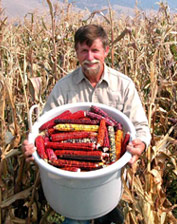Roundup herbicide found in air, rain, and streams
By Ken Roseboro
Published: October 1, 2011
Category: GM Food Labeling and Regulations

To access all the articles in this month's issue of The Organic & Non-GMO Report, SUBSCRIBE NOW.
Glyphosate herbicide, known by its trade name Roundup, is commonly found in rain and rivers in agricultural areas in the Mississippi River watershed, according to two US Geological Survey studies released in August.
“It’s out there in significant levels”
Glyphosate is used in almost all agricultural and urban areas of the United States. The greatest glyphosate use is in the Mississippi River basin, where most applications are to kill weeds on genetically modified corn, soybeans and cotton. Overall, agricultural use of glyphosate has increased 8-fold from less than 11,000 tons in 1992 to more than 88,000 tons in 2007.
“Though glyphosate is the mostly widely used herbicide in the world, we know very little about its long term effects to the environment,” says Paul Capel, USGS chemist and an author on this study. “This study is one of the first to document the consistent occurrence of this chemical in streams, rain and air throughout the growing season. This is crucial information for understanding where management efforts for this chemical would best be focused.”
In these studies, glyphosate was frequently detected in surface waters, rain and air in areas where it is heavily used in the basin. The consistent occurrence of glyphosate in streams and air indicates its transport from its point of use into the broader environment.
Capel told Reuters that glyphosate is “out there in significant levels. It is out there consistently.”
He said more tests were needed to determine how harmful glyphosate might be to people and animals.
Adds to mounting concerns with Roundup
The presence of glyphosate and its degradation product, aminomethylphosphonic acid (AMPA), in surface waters means that drinking water quality and aquatic wildlife may be put at risk. Studies have shown many aquatic species are affected by the herbicide and its breakdown product, and there is growing concern about the safety of the product for human health.
USGS found glyphosate in more than 60% of air and rain sampled at three locations in Mississippi, Iowa and Indiana, with AMPA found in more than 50% of samples.
Commenting on USGS’s findings, Pete Riley of United Kingdom-based GM Freeze said: “The Mississippi Basin has been subjected to glyphosate application on a massive scale for the last 15 years. As a result of this giant uncontrolled experiment, the USGS is now finding that glyphosate and its breakdown products are turning up in rainfall and rivers, and not, as Monsanto would have us think, being safely locked up in the soil. The mounting evidence on the safety and movement of glyphosate now merits a ban on GM herbicide tolerant crops.”
© Copyright The Organic & Non-GMO Report, October 2011





